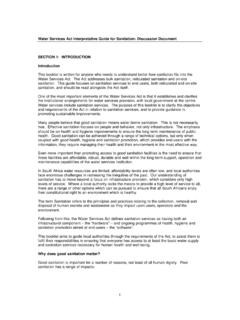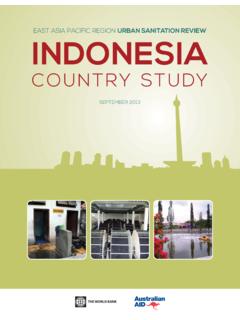Transcription of MEETING THEMDG DRINKING WATER AND SANITATION …
1 M E E T I N G T H E M D G D R I N K I N G. WATER AND SANITATION TARGET. THE URBAN AND RURAL CHALLENGE OF THE DECADE. MDGREGIONALGROUPINGS. Photo credits: UNICEF Photolibrary 43. Design: The world is still on track for reaching the MDG DRINKING WATER target, but the trend appears to be deteriorating. On current trends, the world will miss the SANITATION target by more than half a billion people. - Every year, unsafe WATER , coupled with a lack of basic SANITATION , kills at least million children under the age of ve years more than eight times the number of people who died in the Asian tsunami of 2004. - At the beginning of the WATER for Life decade, billion people did not have access to an improved source of DRINKING WATER . - 84% of the population without access to an improved source of DRINKING WATER live in rural areas. - billion people, more than 40% of the world population, do not use a toilet, but defecate in the open or in unsanitary places.
2 In 2004, more than three out of every ve rural people, over 2 billion, did not have access to a basic SANITATION facility. - If the current trend persists, nearly billion rural dwellers will still not have access to improved SANITATION by 2015. - In 2004, urban SANITATION coverage was more than double the rural SANITATION coverage. - Although 73% of rural dwellers have access to an improved source of DRINKING WATER , only 30% have access to piped WATER in the home. Keeping up with the population increase is a major challenge for urban areas; maintaining current coverage levels till 2015 requires serving 700 million urban dwellers over the coming decade. - Migration from rural to urban areas poses a major challenge for city planners; extending basic DRINKING WATER and SANITATION services to periurban and slum areas to reach the poorest people is of the utmost importance to prevent outbreaks of cholera and other WATER -related diseases in these often overcrowded places.
3 - Urban DRINKING WATER coverage has remained at 95% since 1990. Urban SANITATION coverage has increased by only one percentage point, from 79% to 80%. - About 770 million and 700 million urban people gained access to improved DRINKING WATER and SANITATION , respectively, during 1990 2004. World Health Organization United Nations Children's Fund Avenue Appia 20 3 UN Plaza 1211 Geneva 27 New York, NY 10017. Switzerland USA. M E E T I N G T H E M D G D R I N K I N G. WATER AND SANITATION TARGET. THE URBAN AND RURAL CHALLENGE OF THE DECADE. WHO Library Cataloguing-in-Publication Data MEETING the MDG DRINKING WATER and SANITATION target : the urban and rural challenge of the decade. resources development. WATER - supply and distribution. supply. development goals. Joint Monitoring Programme for WATER Supply and SANITATION . Health Organization. ISBN 92 4 156325 7 (NLM classi cation: WA 675). ISBN 978 92 4 156325 3. World Health Organization and UNICEF 2006.
4 All rights reserved. Publications of the World Health Organization can be obtained from WHO Press, World Health Organization, 20 Avenue Appia, 1211. Geneva 27, Switzerland (tel: +41 22 791 3264; fax: +41 22 791 4857; e-mail: The World Health Organization and UNICEF welcome requests for permission to reproduce or translate their publications whether for sale or for noncommercial distribution. Applications and enquiries should be addressed to WHO, Of ce of Publications, at the above address (fax: +41 22 791 4806; e- mail: or to UNICEF, Division of Communication, 3 United Nations Plaza, New York 10017, USA (fax: +1 212 303 7985; e-mail: nyhqdoc. The designations employed and the presentation of the material in this publication do not imply the expression of any opinion whatsoever on the part of the World Health Organization or UNICEF concerning the legal status of any country, territory, city or area or of its authorities, or concerning the delimitation of its frontiers or boundaries.)))
5 Dotted lines on maps represent approximate border lines for which there may not yet be full agreement. The mention of speci c companies or of certain manufacturers' products does not imply that they are endorsed or recommended by the World Health Organization or UNICEF in preference to others of a similar nature that are not mentioned. Errors and omissions excepted, the names of proprietary products are distinguished by initial capital letters. The World Health Organization and UNICEF do not warrant that the information contained in this publication is complete and correct and shall not be liable for any damages incurred as a result of its use. Printed in Switzerland CONTENTS. Foreword .. 2. De nitions and data sources .. 4. Purpose of this report .. 5. Challenge of the WATER for Life decade .. 6. DRINKING WATER coverage .. 8. DRINKING WATER trends over 2005 2015 .. 10. Urban/rural disparities in access to DRINKING WATER .. 12. Urban and rural DRINKING WATER in the WATER for Life decade.
6 14. SANITATION coverage .. 16. SANITATION trends over the WATER for Life decade .. 18. Urban/rural disparities in access to SANITATION .. 19. Urban and rural SANITATION perspectives .. 20. Monitoring DRINKING WATER and SANITATION .. 22. JMP mission 26. Country, regional and global DRINKING WATER and SANITATION coverage, 1990 and 2004 .. 28. Reaching the MDG DRINKING WATER and SANITATION target: regional and global status in 1990 and 2004, and efforts required in 2005 2015 .. 40. MDG regional groupings .. 41. 1. FOREWORD. Safe DRINKING WATER , SANITATION and good hygiene are fundamental to health, survival, growth and development. However, these basic necessities are still a luxury for many of the world's poor people. Over billion of our fellow citizens do not use DRINKING WATER from improved sources, while billion lack basic SANITATION . Safe DRINKING WATER and basic SANITATION are so obviously essential to health that they risk being taken for granted.
7 Efforts to prevent death from diarrhoea or to reduce the burden of such diseases as ascaris, dracunculiasis, hookworm, schistosomiasis and trachoma are doomed to failure unless people have access to safe DRINKING WATER and basic SANITATION . Lack of basic SANITATION indirectly inhibits the learning abilities of millions of school-aged children who are infested with intestinal worms transmitted through inadequate SANITATION facilities and poor hygiene. The Millennium Development Goals (MDGs) have set us on a common course to push back poverty, inequality, hunger and illness. The world has pledged to reduce by half the proportion of people without sustainable access to safe DRINKING WATER and basic SANITATION . Entering the International Decade for Action, WATER for Life, 2005 2015, this report looks at the challenge of MEETING the MDG target for DRINKING WATER and SANITATION . Achieving the MDG DRINKING WATER and SANITATION target poses two major challenges: a rapid pace of urbanization, which requires a major effort even to keep up the current coverage levels; a huge backlog of rural people unserved with basic SANITATION and safe DRINKING WATER , which calls for an intensive mobilization of resources to reduce the vast coverage gap between urban and rural populations.
8 Sub-Saharan Africa remains the area of greatest concern. It is a region of the world where, over the period 1990 2004, the number of people without access to DRINKING WATER increased by 23% and the number of people without SANITATION increased by over 30%. More intensive, effective and concerted action by all stakeholders is needed if the MDG DRINKING WATER and SANITATION target is to be met in this region. We call on all countries to set realistic targets, develop achievable action plans, and allocate the nancial and human resources needed to bring safe DRINKING WATER and basic SANITATION to their populations, in a sustainable manner, while protecting the basic needs of poor and vulnerable people. This effort must be made, not only for humanitarian reasons, but also because it is highly cost-effective, reduces health costs enormously, and is directly related to health, equity and economic growth, which are prerequisites for poverty alleviation.
9 DEFINITIONS AND. DATA SOURCES. T. his report by the surveys ( ). by these surveys allows JMP. WHO/UNICEF Joint to estimate the DRINKING WATER Monitoring Programme Population data including and SANITATION coverage gures for WATER Supply and SANITATION population projections and a and hence to derive coverage (JMP) is concerned with the breakdown of urban and rural trends nationally, regionally and MDG target to halve, by 2015, populations are obtained from globally. The JMP method for the proportion of people the United Nations Population deriving coverage estimates can without sustainable access to Division: be viewed in greater detail at: safe DRINKING WATER and basic World population prospects: the SANITATION . The indicators of 2004 revision (POP/DB/WPP/ progress towards this target are: February 2005). proportion of population IMPROVED DRINKING . with sustainable access to Data sources used to calculate WATER SOURCES. an improved DRINKING WATER the proportion of population > Piped WATER into dwelling, source, urban and rural; using different types of DRINKING plot or yard > Public tap/standpipe proportion of population with WATER sources and SANITATION > Tubewell/borehole access to improved SANITATION , facilities are national censuses > Protected dug well > Protected spring urban and rural.
10 And nationally representative > Rainwater collection household surveys. Most of the UNIMPROVED DRINKING . The proportion of the data points used by the JMP WATER SOURCES. population with access to safe are provided by Demographic > Unprotected dug well > Unprotected spring DRINKING WATER is an indicator and Health Surveys (DHS), > Cart with small tank/drum expressed as the percentage of Multiple Indicator Cluster > Bottled WATER a > Tanker-truck people using improved DRINKING Surveys (MICS), Living Standards > Surface WATER (river, dam, WATER sources or delivery points Measurement Studies (LSMS) lake, pond, stream, canal, irrigation channels). (listed below). Improved DRINKING and World Health Surveys IMPROVED SANITATION . WATER technologies are more (WHS). FACILITIESb likely to provide safe DRINKING > Flush or pour ush to: WATER than those characterized Other sample surveys - piped sewer system - septic tank as unimproved. contributing to the JMP - pit latrine coverage estimates are: > Ventilated improved pit latrine Similarly, the proportion of > Pit latrine with slab the population with access to Core Welfare Indicator > Composting toilet basic SANITATION is an indicator Questionnaires (CWIQ) UNIMPROVED.













